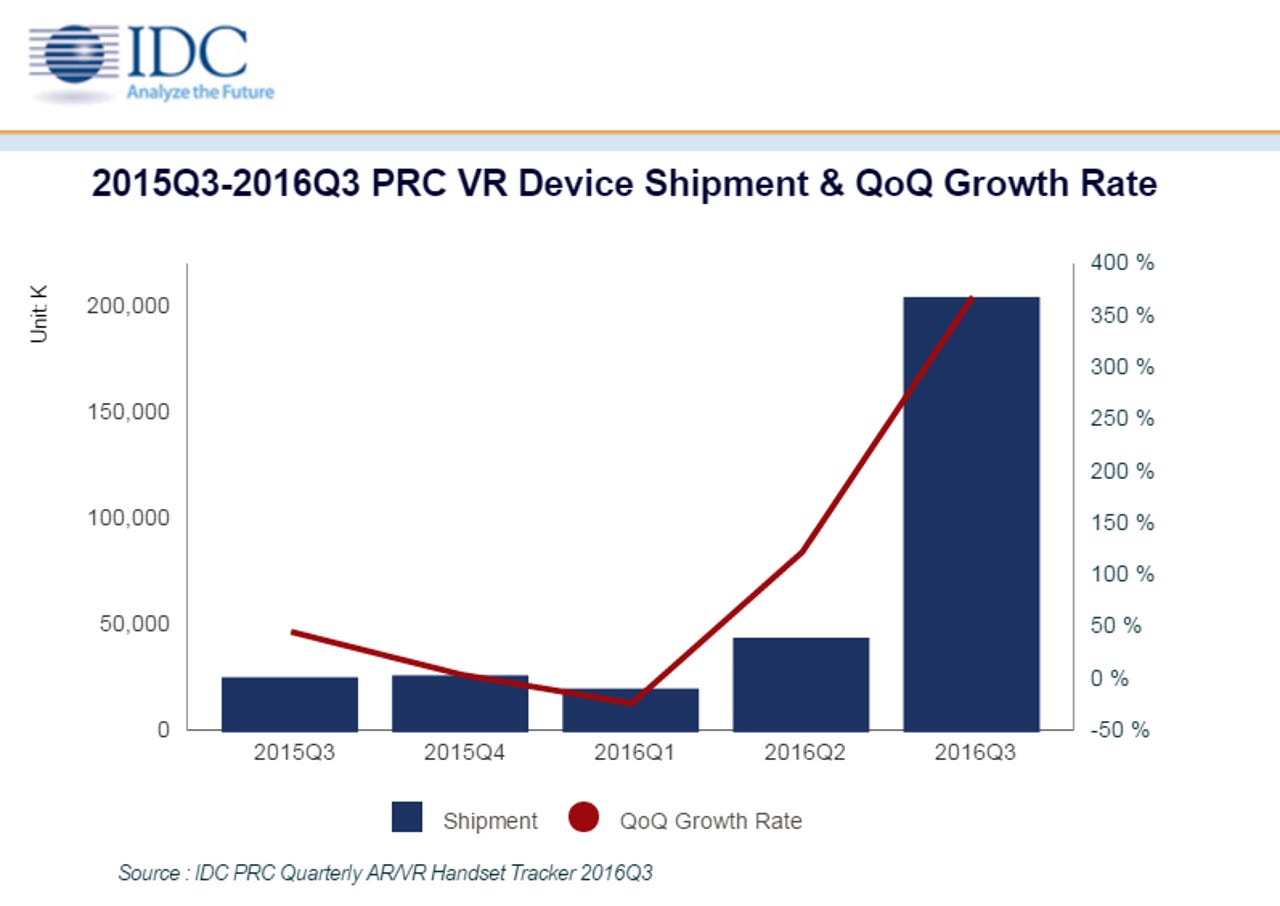China's VR market to expand fourfold in 2017: IDC


(Image: IDC)
China's virtual reality (VR) industry is set to expand by 441.2 percent in 2017 due to more intense competition and new market offerings, according to research firm IDC.
More major players will enter the market this year, the firm said, following releases from Google, Sony PlayStation, and Facebook in 2016, as well as internet companies such as Tencent, LeTV, and Baofeng.
Lenovo, Dell, and HP will work with Microsoft to "improve their competitiveness", while smaller hardware startups that were squeezed from the market last year will likely see investment from capital markets, and will strengthen partnerships with experience stores and business applications.
These smaller VR startups lost ground around Q2, upon the entry of major players and their VR offerings, such as Samsung, HTC, Sony, and LeTV, followed by Xiaomi, Huawei, Microsoft, and Lenovo. Some of these startups were put out of business before shipping a single unit, according to to the firm.
The Chinese market was sluggish this time last year, IDC added, before picking up in Q2 2016. Growth accelerated between Q3 and Q4 thanks to global shipment of Sony's PlayStation VR, and shipments reached 204,000 in Q3 2016, up 367.9 percent from the previous quarter.
IDC also predicts Sony PlayStation, Microsoft, and Vive to become China's top VR platforms, with Google Daydream topping mobile VR. HTC, Sony, and Microsoft will lead growth in head-mounted displays, while screenless head-mounted displays will make up 62.9 percent of all of China's VR shipments, led by mobile phone vendors.
Independent head-mounted displays will also grow, thanks to support from chipmakers and screen producers.
Other factors that will boost growth are better and increased volumes of content, more VR packages and accessories, the opening of VR experience stores across the country, and content that focuses more on entertainment.
In the field of VR for consumer entertainment, Infosys recently partnered with Sony and the Association of Tennis Professionals (ATP) to offer tennis fans the ability to watch a match and visualise player statistics in unison.
Users can also view up to 20 different screens from real court images, television match coverage, social media feeds, and Hawk-Eye footage, with the company planning to launch the capability in time for the French Open in May.
Apart from entertainment, the range of applications for VR continues to expand to multiple industries. In November, New York startup Virtual Rehab began using VR to develop rehabilitation programs for prisoners to prepare them for release by testing their reactions to real-world conflict scenarios and providing them with practical job training.
In healthcare, VR was applied by Australian health insurer Medibank in collaboration with neuropsychologists at Melbourne-based VR developers Liminal for long-stay hospital patients, while Build VR rolled out its VR unit to Australian care homes for dementia patients.
Various studies have also found VR to be effective in treating a range of psychological disorders including phobias, post-traumatic stress disorder, and obsessive-compulsive disorder.
Earlier this month, HTC launched a support program for VR developers working on projects that drive awareness and understanding of global issues such as famine, poverty, gender disparity, and climate change, following in the footsteps of Facebook's "VR for Good" initiative.
"The Vive's room-scale VR capability can be a powerful tool for immersive storytelling, education, and training; their support will empower more people to affect global change, give voices to the most vulnerable, and provide access to new possibilities for the most marginalised," said Gabo Arora, creator of the United Nations' VR Initiative, at the launch.